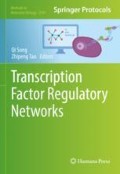Abstract
The TARGET system allows for the rapid identification of direct regulated gene targets of transcription factors (TFs). It employs the transient transformation of plant protoplasts with inducible nuclear entry of the TF and subsequent transcriptomic and/or ChIP-seq analysis. The ability to separate direct TF–target gene regulatory interactions from indirect downstream responses and the significantly shorter amount of time required to perform the assay, compared to the generation of transgenics, make this plant cell-based approach a valuable tool for a higher throughput approach to identify the genome-wide targets of multiple TFs, to build validated transcriptional networks in plants. Here, we describe the use of the TARGET system in Arabidopsis seedling root protoplasts to map the gene regulatory network downstream of transcription factors-of-interest.
Access this chapter
Tax calculation will be finalised at checkout
Purchases are for personal use only
References
Bargmann BO, Marshall-Colon A, Efroni I et al (2013) TARGET: a transient transformation system for genome-wide transcription factor target discovery. Mol Plant 6:978–980
Yoo SD, Cho YH, Sheen J (2007) Arabidopsis mesophyll protoplasts: a versatile cell system for transient gene expression analysis. Nat Protoc 2:1565–1572
Schena M, Yamamoto KR (1988) Mammalian glucocorticoid receptor derivatives enhance transcription in yeast. Science 241:965–967
Bargmann BO, Birnbaum KD (2009) Positive fluorescent selection permits precise, rapid, and in-depth overexpression analysis in plant protoplasts. Plant Physiol 149:1231–1239
Bargmann BO, Birnbaum KD (2010) Fluorescence activated cell sorting of plant protoplasts. J Vis Exp. https://doi.org/10.3791/1673
Para A, Li Y, Marshall-Colón A et al (2014) Hit-and-run transcriptional control by bZIP1 mediates rapid nutrient signaling in Arabidopsis. Proc Natl Acad Sci 111:10371–10376
Sparks EE, Drapek C, Gaudinier A et al (2016) Establishment of expression in the SHORTROOT-SCARECROW transcriptional cascade through opposing activities of both activators and repressors. Dev Cell 39:585–596
Medici A, Marshall-Colon A, Ronzier E et al (2015) AtNIGT1/HRS1 integrates nitrate and phosphate signals at the Arabidopsis root tip. Nat Commun 6:6274
Safi A, Medici A, Szponarski W et al (2021) GARP transcription factors repress Arabidopsis nitrogen starvation response via ROS-dependent and -independent pathways. J Exp Bot. https://doi.org/10.1093/jxb/erab114
Varala K, Marshall-Colón A, Cirrone J et al (2018) Temporal transcriptional logic of dynamic regulatory networks underlying nitrogen signaling and use in plants. Proc Natl Acad Sci 115:6494–6499
Brooks MD, Cirrone J, Pasquino AV et al (2019) Network Walking charts transcriptional dynamics of nitrogen signaling by integrating validated and predicted genome-wide interactions. Nat Commun 10:1569
Alvarez JM, Schinke A-L, Brooks MD et al (2020) Transient genome-wide interactions of the master transcription factor NLP7 initiate a rapid nitrogen-response cascade. Nat Commun 11:1–13
Brooks MD, Juang C-L, Katari MS et al (2021) ConnecTF: A platform to integrate transcription factor–gene interactions and validate regulatory networks. Plant Physiol 185:49–66. https://doi.org/10.1093/plphys/kiaa012
Doidy J, Li Y, Neymotin B et al (2016) “Hit-and-Run” transcription: de novo transcription initiated by a transient bZIP1 “hit” persists after the “run”. BMC Genomics 17:92
Para A, Li Y, Coruzzi GM (2018) μChIP-Seq for genome-wide mapping of in vivo TF-DNA interactions in Arabidopsis root protoplasts. In: Ristova D, Barbez E (eds) Root development: methods and protocols. Springer, New York, pp 249–261
Murashige T, Skoog F (1962) A revised medium for rapid growth and bio assays with tobacco tissue cultures. Physiol Plant 15:473–497
Kim D, Paggi JM, Park C et al (2019) Graph-based genome alignment and genotyping with HISAT2 and HISAT-genotype. Nat Biotechnol 37:907–915
Dobin A, Davis CA, Schlesinger F et al (2013) STAR: ultrafast universal RNA-seq aligner. Bioinformatics 29:15–21
Anders S, Pyl PT, Huber W (2015) HTSeq – a python framework to work with high-throughput sequencing data. Bioinformatics 31:166–169
Liao Y, Smyth GK, Shi W (2014) featureCounts: an efficient general purpose program for assigning sequence reads to genomic features. Bioinformatics 30:923–930
Love MI, Huber W, Anders S (2014) Moderated estimation of fold change and dispersion for RNA-seq data with DESeq2. Genome Biol 15:550
Ewels P, Magnusson M, Lundin S, Käller M (2016) MultiQC: summarize analysis results for multiple tools and samples in a single report. Bioinformatics 32:3047–3048
Acknowledgments
This work was supported by NIH Grant R01-GM121753 to G.M.C., NIH NIGMS Fellowship F32GM116347 to M.D.B., and USDA-NIFA Hatch VA-160133 and Multistate VA-136377 projects to B.O.R.B.
Author information
Authors and Affiliations
Corresponding author
Editor information
Editors and Affiliations
Rights and permissions
Copyright information
© 2023 The Author(s), under exclusive license to Springer Science+Business Media, LLC, part of Springer Nature
About this protocol
Cite this protocol
Brooks, M.D., Reed, K.M., Krouk, G., Coruzzi, G.M., Bargmann, B.O.R. (2023). The TARGET System: Rapid Identification of Direct Targets of Transcription Factors by Gene Regulation in Plant Cells. In: Song, Q., Tao, Z. (eds) Transcription Factor Regulatory Networks. Methods in Molecular Biology, vol 2594. Humana, New York, NY. https://doi.org/10.1007/978-1-0716-2815-7_1
Download citation
DOI: https://doi.org/10.1007/978-1-0716-2815-7_1
Published:
Publisher Name: Humana, New York, NY
Print ISBN: 978-1-0716-2814-0
Online ISBN: 978-1-0716-2815-7
eBook Packages: Springer Protocols

